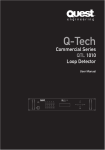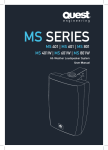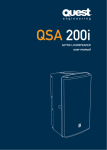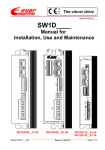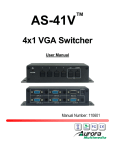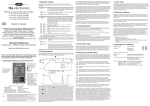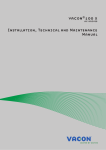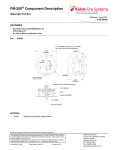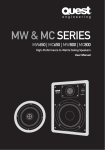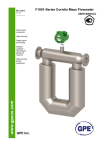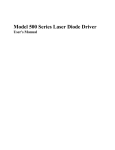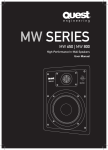Download Q-Tech
Transcript
Q-Tech Commercial Series QTA6060M/6120M/6240M Mixer Amplifiers User Manual QTA 6060M CHANNEL 1 MIN MAX CHANNEL 2 MIN MAX CHANNEL 3 MIN MAX CHANNEL 4 MIN MAX CHANNEL 5 MIN MAX OUTPUT LEVEL PUBLIC ADDRESS AMPLIFIER BASS MIN Pwr -10 TREBLE MAX MIN MASTER MAX MIN MAX -8 -3 0 +3 +8 POWER WARNING THIS APPLIANCE MUST BE EARTHED General Installation DO NOT run unbalanced high impedance microphone cables near mains, data, telephone or 70/100V line cables. DO NOT run 70/100V line cable near data, telephone or other low voltage cables. DO NOT exceed 90% of the amplifiers output power when using 70/100V line (speech only). DO NOT exceed 70% of the amplifiers output power when using 70/100V line (high level background music). IMPORTANT The wires in the mains lead are coloured In accordance with the following code: Green and Yellow: Earth (E) Blue: Neutral (N) Brown: Live (L) As the colours of the wires in the mains lead of this apparatus may not correspond with the coloured markings identifying the terminals in your plug proceed as follows: The wire which is coloured green and yellow must be connected to the terminal which is marked with the letter N or coloured black. The wire which is marked with the letter L or coloured red. If a 13 Amp (B.S.1363) plug or any other type of plug is used, a 5 Amp fuse must be fitted either in the plug or at the distribution board. DO NOT use voice paging horn loudspeakers for background music unless the loudspeaker has been specifically designed for this purpose. AVOID jointing the microphone cable, when this is unavoidable make sure a good screened connector is used. ALWAYS use balanced low impedance microphone cable terminating to balanced inputs on long cable runs. ALWAYS use a mains grade double insulated cable for the loudspeaker cable runs when run in conduit together with power cables. ENSURE that all loudspeakers are in-phase. ENSURE that there are no short circuits on the loudspeaker line before connecting to the amplifier. It is also advisable to check the final impedance to the amplifier with a dedicated impedance meter to determine power draw is within the amplifiers limits. QTA-6060M/6120M/6240M User Manual Contents Introduction. . . . . . . . . . . . . . . . . . . . . . . . . . . . . . . . . . 2 Description . . . . . . . . . . . . . . . . . . . . . . . . . . . . . . . . . . 2 Front Panel Layout. . . . . . . . . . . . . . . . . . . . . . . . . . . . . 3 Rear Panel Layout. . . . . . . . . . . . . . . . . . . . . . . . . . . . . 4 Power Source . . . . . . . . . . . . . . . . . . . . . . . . . . . . . . . . 5 Main Connections. . . . . . . . . . . . . . . . . . . . . . . . . . . . . 5 Power Amp Output . . . . . . . . . . . . . . . . . . . . . . . . . . . . 6 1 Installation Practice . . . . . . . . . . . . . . . . . . . . . . . . . . . 6 Operation. . . . . . . . . . . . . . . . . . . . . . . . . . . . . . . . . . . . 7 Specifications . . . . . . . . . . . . . . . . . . . . . . . . . . . . . . . . 8 Trouble Shooting. . . . . . . . . . . . . . . . . . . . . . . . . . . . . . 9 Technical Notes. . . . . . . . . . . . . . . . . . . . . . . . . . . . . . . 9 Q-Tech Commercial Series User Manual QTA-6060M/6120M/6240M User Manual Introduction Description Congratulations on your purchase of a new Q-Tech Commercial series amplifier. Quest Engineering Q-Tech Series amplifiers are engineered and built to a standard that will satisfy the most demanding environments of commercial installation audio. The Q-Tech Range of Mixer amplifiers are of very high quality and come supplied full of features. For your safety and continuing reliability of your Quest amplifier, please read all the safety instructions and familiarize yourself with the amplifiers functions and installation procedure section before installing and operating the amplifier. Quest has paid great attention to detail in order to maintain strict quality assurance standards of all Q-Tech Series amplifiers. 2 It follows that if your audio installation is completed with the same attention to detail, your amplifier will deliver its best results. Please red the section: Constant Voltage Distributed Speaker Systems Demystified. Unpacking: Please inspect the amplifier carefully immediately after unpacking. If you find any damage, notify your supplier/ dealer immediately. Only the shipper may file a damage claim with the carrier for damage incurred during shipping. Also check that the voltage is correct for your local power supply. User Manual Q-Tech Commercial Series • In built chime tone module • Phantom Power on all mic inputs • Telepaging input with selectable priority • 24v DC power inputs • Built in Mic/Line Priority • Low Signal to Noise ratio • Complete with barrier strip, XLR or ¼ in jack Mic input connections • Pre Out function • Tape Output • External Mixer input • All Mic inputs selectable as Mic or Line • The Mixer amps can also drive up to three external power amps QTA-6060M/6120M/6240M User Manual Front Panel Layout QTA 6060M CHANNEL 1 MIN MAX CHANNEL 2 MIN MAX CHANNEL 3 MIN MAX CHANNEL 4 MIN MAX CHANNEL 5 MIN OUTPUT LEVEL PUBLIC ADDRESS AMPLIFIER BASS MAX MIN Pwr -10 TREBLE MAX MIN -8 MASTER MAX MIN -3 0 +3 +8 POWER MAX 1 Channel 1 Volume Control 7 Master Tone Control (Treble) 2 Channel 2 Volume Control 8 Master Volume Control 3 Channel 3 Volume Control 9 Power On / Off switch 4 Channel 4 Volume Control 10 Power On / Off indicator LED 5 Channel 5 Volume Control 11 Output Level indicator LED 6 Master Tone Control (Bass) Q-Tech Commercial Series 3 User Manual QTA-6060M/6120M/6240M User Manual 230V Rear Panel Layout 4 1 Mains Input Socket 13 MIC 4/Aux 4 Selector Switch 25 Chime Selector Switch 2 Power Fuse 14 Aux 4 Input (RCA Jack) 26 Chime Screw Terminal 3 Earth Connection Screw 15 Aux 3 Input (RCA Jack) 27 Speaker Output Terminals 4 Power Amp in 16 MIC 3/Aux 3 Selector Switch 28 DC Power Supply Terminals 5 Pre out (RCA Jack) 17 MIC 3 Input (XLR Jack) 29 MIC 5 Screw Terminal input 6 Tape Output (RCA Jack) 18 MIC 2 Input (XLR Jack) 30 MIC 4 Screw Terminal input 7 Aux 6 Level Control 19 MIC 2/Aux 2 Selector Switch 31 MIC 3 Screw Terminal input 8 Aux 6 Input (RCA Jack) 20 Aux 2 Input (RCA Jack) 32 MIC 2 Screw Terminal input 9 Aux 5 Input (RCA Jack) 21 Aux 1 Input (RCA Jack) 33 MIC 1 Screw Terminal input 10 MIC 5/Aux 5 Selector Switch 22 MIC 1/Aux 1 Selector Switch 34 Tel Page Input (Screw Terminals) 11 MIC 5 Input (XLR Jack) 23 MIC 1 Input (XLR Jack) 35 Tel Input Level Control 24 Mains Voltage (115V/240V) Selector Switch 36 MIC 1 Mute On/Off Switch 12 User Manual MIC 4 Input (XLR Jack) Q-Tech Commercial Series QTA-6060M/6120M/6240M User Manual Power Source The supply transformer has been designed for use on either 115Vac or 240Vac, selected by a slide switch on the rear panel. The amplifier is factory set at 240Vac mains voltage. Battery Connection (24V DC) When using external batteries, earth the amplifier via the screw terminals on the rear of the amplifier because of the high voltages present. Electrical stability of the system will be improved by providing a good earth ground. NOTE: the connection cable must be fitted with an in-line fuse. Quick blow type 5A( 60W) 8A(120W) 15A(240W). When connecting batteries, please ensure correct polarity. Main Connections Microphone Inputs Five microphone inputs are provided, the microphone amplifiers are an electronically balanced, transformer-less design configured for optimum low noise performance. The input impedance is greater than 2kΩ and is suitable for microphones in the 200Ω to 600Ω range. For balanced microphones, connect the cable screen to pin 1, the in phase signal to pin 2 and the reverse phase to pin 3. To operate the channel in the unbalanced mode, connect pin 3 to pin 1 (ground) inside the XLR cable plug. Use pin 2 as hot and pin 1 as screen (ground), see diagram below: Pin Assignments: 2 1 2 1 3 3 Plug Socket Viewed from Solder Side of Plug/Soceket Balanced Audio (3 pole XLR): Pin 1: Ground / Screen Pin 2: In phase / +ve / Hot Pin 3: Out of phase / -ve / Cold Unbalanced Audio (3 pole XLR): Pin 1: Ground / Screen Pin 2: Signal Pin 3: Ground / Screen (connect to pin 1) For best performance when using long lines between microphones/mixer and or amplifier use balanced lines. These have the effect of cancelling out any noise or hum that may be induced into the cables. Phantom power facilities are provided; either of the mic inputs can be configured to operate with 15V phantom power by setting the relevant jumper to the ON position. Care should be taken to ensure that phantom power is activated only when the microphone connected to the input requires external phantom power In addition to the XLR microphone inputs, the option exists for installing Microphones via the barrier strip provided. VOX Muting The TEL input has voice activated (VOX priority) muting over CH1~CH5 and AUX 6. Priority Microphone, Mic1 input, has VOX priority over CH 3~6 and Line input signals but does NOT mute Channel 2 input. 5 Line (Aux/CD) Connection The equipment provides an auxiliary input which may be used for connecting other signal sources such as a Radio Tuner, CD or Cassette player. A push button switch is located on the rear panel for selection of, Mic1→Aux1, Mic2→→Aux2, etc. The line level Control on the front panel operates on each of the input sources. To operate, select the desired music source using the slide switch and turn the “Channel” control clockwise to increase the volume, or anti-clockwise to reduce the volume. The Aux / input sockets are standard stereo RCA phono. Single sockets are supplied and these are linked together internally. This allows stereo signal sources to be used without the need to obtain a special lead, however you may wish to check with the manufacturer of the signal source to ensure that no damage will result if the left and right output channels are put in parallel. Q-Tech Commercial Series User Manual QTA-6060M/6120M/6240M User Manual RCA Phono Plug Connections Low Impedance 8Ω or (4Ω): Tape Output Connection This output allows connection of standard low impedance loudspeakers. The minimum impedance must be 4Ω. When two or more loudspeakers are in use, ensure that they are wired in such a way that the impedance load is between 4Ω and 16Ω. These are standard RCA stereo phono sockets, and provide a mixed output suitable for connection to a tape or digital recorder. As a guide for the correct gauge of wire, we recommend the following: Pre Out / Aux Out 6 The horseshoe jumper “U” connects the mixer/preamplifier stage to the power amplifier stage. This Insert Point will allow for connection of signal processors such as equalisers, compressors or Feedback Exterminators. The Insert Point is located (electronically) between the mixer and power amplifier sections of the amplifier. It allows for the “mixed” output of the amplifier to be processed externally and then returned to the power amplifier section of the amplifier. The connecting link must be plugged in for normal operation as a mixer/amplifier. “PRE OUT” is after the tone controls and the master volume control. Chime Output Chime is a two tone “DING DONG”. This is obtained by shorting screw terminals. Chime tones mute all channels. A slide switch located adjacent to the speaker output terminal strip allows the enable/disable Chime function. Power Amp Output Additional amplification can be achieved by connecting the “PRE OUT (2)” output to another power amplifier. Under normal conditions, up to three power amplifiers can be connected in this way. Loudspeaker Connection Note: Use only 100V or 70V (Selectable) Line Loudspeakers User Manual Q-Tech Commercial Series 100V 70V Up to 50m AWG25-26 (0.15mm2) 50m - 200m AWG20 (0.5mm2) Over 200m AWG18 (0.75mm2) Up to 50m AWG24 (0.20mm2) 50m - 200m AWG17 (1.0mm2) Over 200m AWG16 (1.5mm2) Up to 10m AWG18 (0.75mm2) 10m - 30m AWG13 (2.50mm2) Low Imped. (4) Installation Practice Step 1. Take a piece of figure-8 cable, connect the stripe/coloured wire to the100V terminal and the uncoloured wire to the COM on the amplifier terminal strip. Step 2. Connect the other end of the wire (uncoloured) to the Com/EARTH connection on the ceiling speaker transformer and the other + (strip) wire to the required voltage taping. Step 3. Take a second piece of figure-8 cable and connect the plain wire to the parallel COM connection and the other + (stripe) wire to the parallel output from the transformer terminal block and connect it in the same way to the next ceiling speaker. QTA-6060M/6120M/6240M User Manual Step 4. Continue this process until all the ceiling speakers are connected in a parallel connection with all the COM connections and all the wattage connections following a parallel connection. Common problems with ceiling speaker installations System is distorting. Check for the following causes: 1. Too many speakers set to too high a power tapping for the power of the amplifier. Solution: Calculate the total power draw and re connect the speakers to a lower the wattage tapping. (See “Determining power by calculating total impedance.” on page 10) Some cheap ceiling speakers have incorrect taping labels. A 10 watt speaker may really be drawing 15 or 20 watts. The only way to test this is with an impedance meter on a single speaker. A 15% discrepancy can mean that a 100 watt system will only be able to power 7 or 8 x10 watt speakers safely. Be aware of this booby trap. Always plan to have 20% more power than you think you will need. 2. Incorrect output connection: If you accidentally connect your terminal strip on the amplifier to the 8 ohm output instead of the 100/70V line, you will have distortion and risk damaging the amplifier. 3. Short circuits and no circuits: Check that your wiring has not been accidentally cut, miss-connected or generally damaged in the course of installation. This can be common with building sites with multiple trades people installing equipment into the same ceiling cavities as the audio system. Operation For the best noise performance, turn the input level control to a high setting and use the Master as the volume control. Use the other input level controls to set the required mixing ratios. If you are using the auxiliary inputs, adjust the bass and treble controls to get the desired sound. The Q-Tech range of amplifiers has a 7 stage LED ramp for Signal Present/Overload (green/ red). Green indication occurs when there is a signal present. This LED display should be glowing green when signal is present. If this lamp is off, the reason maybe: A. The Input may not be connected. B. There is little or no signal present at the moment. C. There is a Mic connected to a channel switched to LINE. D. The Mic needs Phantom Power (See Rear Panel Layout). 7 E. The LEVEL control needs to be increased (clockwise). F. The cable is not wired properly A red glowing LED indicates that the levels are so high that distortion due to clipping is occurring or imminent. Check these conditions: A. The LEVEL control may be turned too high. B. The Output of the preceding device may need to be reduced. C. The Input may be switched to MIC with a line-level source. Switch the Input to LINE. Q-Tech Commercial Series User Manual QTA-6060M/6120M/6240M User Manual Specifications Type Mixer Amplifier Model Supply QTA-6060M Mains Voltage QTA-6120M QTA-6250M AC 115V/ 240V, 50 / 60Hz ± 10% Switchable Battery Voltage DC 24V (MAX 10% deviation) Output Power: 60W 120W 240W Speaker outputs: 4Ω, 8Ω, 70V, 100V Tape output: 1V 4.7KΩ Outputs Pre output: 1V, 600Ω Aux Mains Power: 4A/115V Mic 1~5: sensitivity. Adjustable (1mV), 600Ω balanced. Aux 4~6: 150mV, stereo 22K, Inputs TEL: 150mV, Adjustable 600Ω, balanced Power amplifier in: 1V Mic 1~Mic 5: 60Hz ~ 12KHz ± 3dB Aux 1~ 6: 50Hz ~ 15KHz ± 3dB TEL: 50Hz ~ 15KHz ± 3dB Frequency response Total harmonic distortion 8 Less than 1% @ 1KHz, rated power All Volume Controls: 80dB below rated power Mic 1~ 5: 60dB below rated power Tel: 80dB below rated power Aux: 80dB below rated power Signal to noise ratio Bass : ± 10dB at 100Hz Treble : ± 10dB at 10KHz Tone Controls Channel 1~5 volume control Aux 6 volume control Master volume control Tone controls (Bass, Treble) TEL volume control Mute slide switch Mic 1/Aux 1 push switch Rear Mounted Mic 2/Aux 2 push switch Rear Mounted Mic 3/Aux 3 push switch Rear Mounted Mic 4/Aux 4 push switch Rear Mounted Mic 5/Aux 5 push switch Rear Mounted Chime Control AC 115V / 240V voltage Selector switch Controls Indicators Power indicator (LED), output level indicators (6 LEDS) AC power consumption 150W 300W 600W DC power consumption 5A 8A 15A Phantom power Factory set “on” @ 16V, defeatable via internal jumpers TEL mutes all channels Channel 1 can mute Channel 3 ~5, Aux 3~6 Priority Dimensions (H x W x D) mm Weight Colour Mounting options User Manual Q-Tech Commercial Series 88mm(H) x 426mm(W) x 13.5”D 8.5 9.5 11.5 Black Table top or 19” rack mountable / Rack Mount Ears Included QTA-6060M/6120M/6240M User Manual Trouble Shooting Technical Notes If the amplifier doesn’t appear to be working normally, please check the following, Constant Voltage Distributed Speaker Systems Demystified No Power, No indicator Lights working • Make sure amplifier power switch is on. • Make sure mains power switch is on at the wall. • Check the mains and DC fuse. • Replace with only the correct type and rating. Over rated fuses with invalidate warranty. Distorted Output • Check that the speaker type is correct for the output that you are using (ie.4-16Ω, 70V or 100V line). • Check for any short circuits on the speaker line. Very Low Output Volume • Make sure that the input is the correct level (check for shorted connectors). In a typical paging and background music speaker installation, a quantity of loudspeakers are placed across a single amplifier in a parallel wiring configuration (see Fig. 1.). Each ceiling speaker will contain a small transformer and you will notice that the connection block near the transformer will have a common terminal (C or earth), and a number of wattage terminals. Connect the wattage setting terminal for the desired acoustic output (volume) level you need from each individual speaker. This will be a 100V setting in Europe and most of Asia and 70V in the USA. (See the explanation below) 100V Line Public Address System 9 • Check for any short circuits on the speaker line. • Check if signal LED on the front panel is lit to indicate there is signal. • If it is not lit there is no signal present. Continually Blows Fuses • Make sure that the speaker line is not shorted. • Check speaker types, ratings and if on correct output. Amplifier Keeps on Cutting In & Out • Make sure that there is adequate ventilation around the amplifier. • Check the vent slots on the front, top and sides are not covered or blocked and the fan on the rear is functioning correctly. • Check also speaker types, ratings and for any short circuits on the speaker line. No Output Volume • Check the Send/Return link is in place. Fig. 1 Remote Speaker with 100V Line Transformers Often some speakers need to be set at different volume output levels, and the calculations involved in determining the actual load impedance at the amplifier’s output can be quite involved but there is a simple technique for not overloading the amplifier. As for the amplifiers, there are two common standards, 100 Volt line in Europe and Asia and 70 Volt line on the American continent. For the purpose of simple calculations, we will use the European standard for this exercise. On the rear of a 70/100V amplifier you will find an output terminal strip. This terminal strip will contain a number of + voltage outputs (70V 100V) and a terminal at one end for the negative return wire (COM). Q-Tech Commercial Series User Manual QTA-6060M/6120M/6240M User Manual A low impedance terminal will be for 8-ohm speaker installations and is under no circumstances to be connected to a transformer type speaker system. How to calculate the correct number of speakers and what wattage connection for a given amplifier power. If you connect too many speakers to an amplifier you will have distortion, overheating of the amplifier and generally poor performance. The problem is not really “too many speakers”, it is more a problem of “too much wattage draw exceeding the output capability of an amplifier. A similar problem would be trying to draw 2,000 watts from a 1,000 watt generator. Sooner or later…. Expect a system failure. 10 Let us take a 100 watt amplifier. If you have 20 speakers and you set them at the 5 watt taping, you will have a total 100 watt draw which is the maximum output of the amplifier. This is correct in theory but in practice you will be safer connecting 18 speakers, not 20. The reason is that most ceiling speakers draw more than their claimed wattage. The alternative would be to connect the speakers to the 4 watt transformer terminal giving you a theoretical total draw of 80 watts and thus, plenty of “headroom”. One watt difference is not very noticeable as far as output sound pressure level in concerned. A system that does not distort will give much clearer voice reproduction than a louder system that is distorting or loosing the sibilant frequencies. There is a formula for testing the potential power of the system by measuring the impedance of each speaker and then adding all the figures to a total impedance, which is then compared to the amplifier’s expected impedance/power figures. User Manual Q-Tech Commercial Series The quick way is to just add up all the wattages and then give yourself 10-20% headroom by reducing the number of speakers per amplifier or lowering the wattages slightly. For the benefit of those who want to calculate the power of the system with a formula. See below: Determining power by calculating total impedance. The alternative to counting the speaker taping watts is to calculate the total impedance of the line, which will also indicate the wattage necessary to drive the system correctly. The computational formula is voltage squared divided by impedance: Power = Voltage2 / Impedance. When the speaker line reaches its top voltage of 70 Volts, the formula is: Power = 5000 / Impedance (because 70 squared equals 5000). To measure impedance a dedicated meter is required. These use a 1k frequency to send an alternating current through the transformer(s). The resulting figure indicated by the meter’s dial can be cross referenced with the meter’s impedance chart to see what value should be expected and the power that will be required. QTA-6060M/6120M/6240M User Manual High impedance of speakers and output calculation table for 100Volt systems Output Impedance Output Impedance Output 0.1W 100KΩ 10W 1KΩ 40W Impedance 250Ω 0.5W 20KΩ 15W 667Ω 50W 200Ω 133Ω 1W 10KΩ 20W 500Ω 75W 2W 5KΩ 25W 400Ω 100W 100Ω 3W 3.33KΩ 30W 333Ω 150W 66.7Ω 5W 2KΩ 35W 286Ω 200W 50Ω (100V plan) P = E x E / Z = 100x100 / Z = 10,000 / Z P: Power(W), Z : Impedance (Ω), E : 100V(Designed voltage of a general-use amplifier) 11 Q-Tech Commercial Series User Manual QTA-6060M/6120M/6240M User Manual 12 User Manual Q-Tech Commercial Series www.questaudio.net Quest Engineering Pty Ltd 86 Derby St. Pascoe Vale VIC 3055 Ph 613 9354 9133 | Fax 613 9354 9233
















